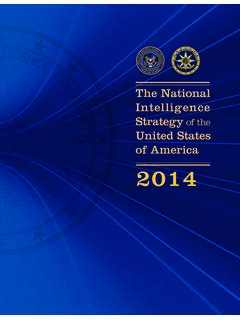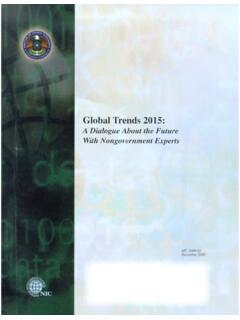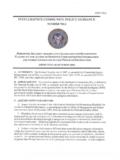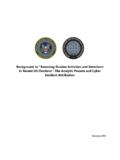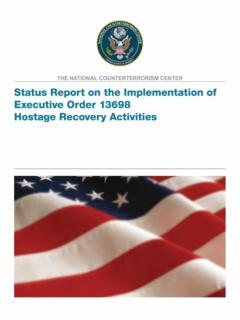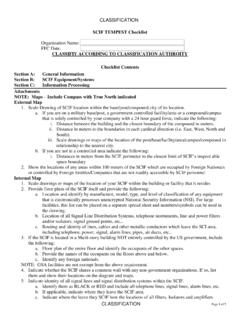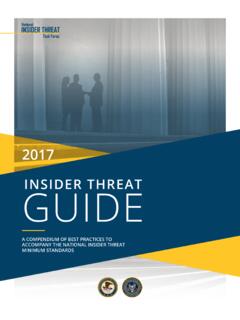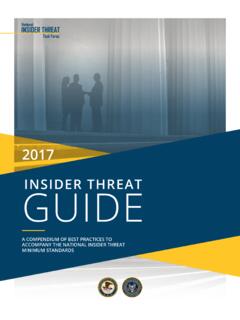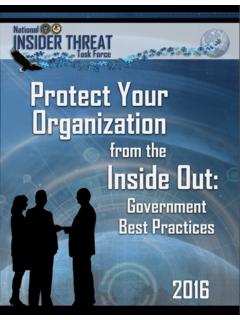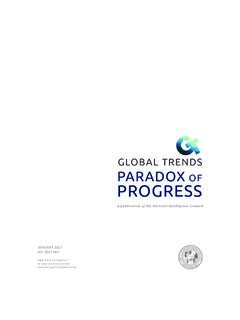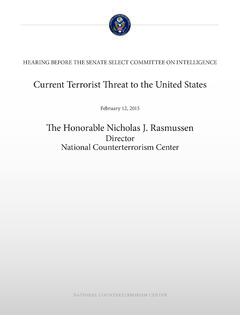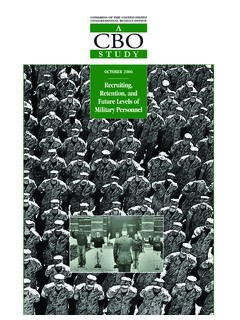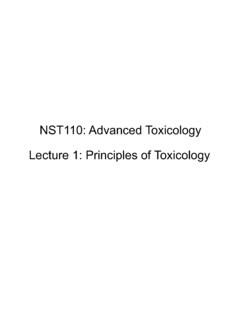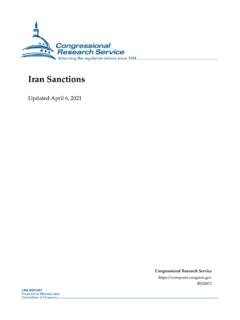Transcription of April 9, 2021 - dni.gov
1 April 9, 2021 [ 2 ] April 9, 2021 I N T R O D U C T I O N This annual report of worldwide threats to the national security of the United States responds to Section 617 of the FY21 Intelligence Authorization Act ( 116-260). This report reflects the collective insights of the Intelligence Community (IC), which is committed every day to providing the nuanced, independent, and unvarnished intelligence that policymakers, warfighters, and domestic law enforcement personnel need to protect American lives and America s interests anywhere in the world. This assessment focuses on the most direct, serious threats to the United States during the next year. The order of the topics presented in this assessment does not necessarily indicate their relative importance or the magnitude of the threats in the view of the IC.
2 All require a robust intelligence response, including those where a near-term focus may help head off greater threats in the future, such as climate change and environmental degradation. As required by the law, this report will be provided to the congressional intelligence committees as well as the committees on the Armed Services of the House of Representatives and the Senate. Information available as of 9 April 2021 was used in the preparation of this assessment. [ 3 ] C O N T E N T S INTRODUCTION .. 2 CONTENTS .. 3 FOREWORD .. 4 CHINA S PUSH FOR GLOBAL 6 RUSSIAN PROVOCATIVE ACTIONS .. 9 IRANIAN PROVOCATIVE 12 NORTH KOREAN PROVOCATIVE ACTIONS .. 15 TRANSNATIONAL ISSUES .. 17 COVID-19 PANDEMIC AND DISEASES .. 17 Climate Change and Environmental Degradation .. 18 Emerging Technology.
3 20 Cyber .. 20 Foreign Illicit Drugs and Organized Crime .. 21 Migration .. 21 GLOBAL TERRORISM .. 23 CONFLICTS AND INSTABILITY .. 25 Afghanistan .. 25 India-Pakistan .. 25 Middle East .. 25 Asia .. 26 Latin America .. 26 Africa .. 27 [ 4 ] F O R E W O RD In the coming year, the United States and its allies will face a diverse array of threats that are playing out amidst the global disruption resulting from the COVID-19 pandemic and against the backdrop of great power competition, the disruptive effects of ecological degradation and a changing climate, an increasing number of empowered non-state actors, and rapidly evolving technology. The complexity of the threats, their intersections, and the potential for cascading events in an increasingly interconnected and mobile world create new challenges for the IC.
4 Ecological and climate changes, for example, are connected to public health risks, humanitarian concerns, social and political instability, and geopolitical rivalry. The 2021 Annual Threat Assessment highlights some of those connections as it provides the IC s baseline assessments of the most pressing threats to US national interests, while emphasizing the United States key adversaries and competitors. It is not an exhaustive assessment of all global challenges and notably excludes assessments of US adversaries vulnerabilities. It accounts for functional concerns, such as weapons of mass destruction and technology, primarily in the sections on threat actors, such as China and Russia. Beijing, Moscow, Tehran, and Pyongyang have demonstrated the capability and intent to advance their interests at the expense of the United States and its allies, despite the pandemic.
5 China increasingly is a near-peer competitor, challenging the United States in multiple arenas especially economically, militarily, and technologically and is pushing to change global norms. Russia is pushing back against Washington where it can globally, employing techniques up to and including the use of force. Iran will remain a regional menace with broader malign influence activities, and North Korea will be a disruptive player on the regional and world stages. Major adversaries and competitors are enhancing and exercising their military, cyber, and other capabilities, raising the risks to US and allied forces, weakening our conventional deterrence, and worsening the longstanding threat from weapons of mass destruction. The effects of the COVID-19 pandemic will continue to strain governments and societies, fueling humanitarian and economic crises, political unrest, and geopolitical competition as countries, such as China and Russia, seek advantage through such avenues as vaccine diplomacy.
6 No country has been completely spared, and even when a vaccine is widely distributed globally, the economic and political aftershocks will be felt for years. Countries with high debts or that depend on oil exports, tourism, or remittances face particularly challenging recoveries, while others will turn inward or be distracted by other challenges. Ecological degradation and a changing climate will continue to fuel disease outbreaks, threaten food and water security, and exacerbate political instability and humanitarian crises. Although much of the effect of a changing climate on US security will play out indirectly in a broader political and economic context, warmer weather can generate direct, immediate impacts for example, through more intense storms, flooding, and permafrost melting. This year we will see increasing potential for surges in migration by Central American populations, which are reeling from the economic fallout of the COVID-19 pandemic and extreme weather, including multiple hurricanes in 2020 and several years of recurring droughts and storms.
7 The scourge of illicit drugs and transnational organized crime will continue to take its toll on American lives, prosperity, and safety. Major narcotics trafficking groups have adapted to the pandemic s challenges to maintain their deadly trade, as have other transnational criminal organizations. [ 5 ] Emerging and disruptive technologies, as well as the proliferation and permeation of technology in all aspects of our lives, pose unique challenges. Cyber capabilities, to illustrate, are demonstrably intertwined with threats to our infrastructure and to the foreign malign influence threats against our democracy. ISIS, al-Qa ida, and Iran and its militant allies continue to plot terrorist attacks against US persons and interests, including to varying degrees in the United States. Despite leadership losses, terrorist groups have shown great resiliency and are taking advantage of ungoverned areas to rebuild.
8 Regional conflicts continue to fuel humanitarian crises, undermine stability, and threaten US persons and interests. Some have direct implications for US security. For example, the fighting in Afghanistan, Iraq, and Syria has direct bearing on US forces, while tensions between nuclear-armed India and Pakistan remain a concern for the world. The iterative violence between Israel and Iran, the activity of foreign powers in Libya, and conflicts in other areas including Africa, Asia, and the Middle East have the potential to escalate or spread. The 2021 Annual Threat Assessment Report supports the Office of the Director of National Intelligence s transparency commitments and the tradition of providing regular threat updates to the American public and the United States Congress. The IC is vigilant in monitoring and assessing direct and indirect threats to US and allied interests.
9 As part of this ongoing effort, the IC s National Intelligence Officers work closely with analysts from across the IC to examine the spectrum of threats and highlight the most likely and/or impactful near-term risks in the context of the longer-term, overarching threat environment. [ 6 ] C H I NA S P U S H F O R G L O B A L P O W E R The Chinese Communist Party (CCP) will continue its whole-of-government efforts to spread China s influence, undercut that of the United States, drive wedges between Washington and its allies and partners, and foster new international norms that favor the authoritarian Chinese system. Chinese leaders probably will, however, seek tactical opportunities to reduce tensions with Washington when such opportunities suit their interests. China will maintain its major innovation and industrial policies because Chinese leaders see this strategy as necessary to reduce dependence on foreign technologies, enable military advances, and sustain economic growth and thus ensure the CCP s survival.
10 Beijing sees increasingly competitive US-China relations as part of an epochal geopolitical shift and views Washington s economic measures against Beijing since 2018 as part of a broader US effort to contain China s rise. China is touting its success containing the COVID-19 pandemic as evidence of the superiority of its system. Beijing is increasingly combining its growing military power with its economic, technological, and diplomatic clout to preserve the CCP, secure what it views as its territory and regional preeminence, and pursue international cooperation at Washington s expense. Regional and Global Activities China seeks to use coordinated, whole-of-government tools to demonstrate its growing strength and compel regional neighbors to acquiesce to Beijing s preferences, including its claims over disputed territory and assertions of sovereignty over Taiwan.
